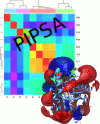
|
PIPSA (Protein Interaction Property Similarity Analysis) |

|
Version 4.0.2, 2019
R. R. Gabdoulline, R.C. Wade,
HITS
gGmbH, Heidelberg, Germany
EMBL,
Heidelberg, Germany

|
PIPSA (Protein Interaction Property Similarity Analysis) |

|
HITS
gGmbH, Heidelberg, Germany
EMBL,
Heidelberg, Germany
New: webPIPSA - PIPSA web server
PIPSA may be used to compute and analyze the pairwise similarity of 3D interaction property fields for a set of proteins.
It is first described in:
N. Blomberg, R.R.
Gabdoulline, M. Nilges and R. C. Wade.
Classification of
protein sequences by homology modeling and quantitative analysis of
electrostatic
similarity.
Proteins: Str.,
Function and Genetics, 37:379-387 (1999).
The interaction
properties
are computed from the 3D coordinates of a set of superimposed proteins.
Similarity indices
can be computed and analysed for three different types of property:
1. The monopole and dipole moments of proteins, which are
analytically
computed descriptors for their electrostatic potentials;
2. Electrostatic potentials obtained by numerically solving the
finite-difference
Poisson-Boltzmann equation (FDPBE) on a grid;
3. Other types of interaction property, e.g. probe interaction
energies
evaluated with the GRID program, that can be mapped on to a grid.
PIPSA produces a
matrix of pairwise similarity indices for each protein interaction
property.
This matrix is converted into a distance matrix which may be used
for clustering or visualization.